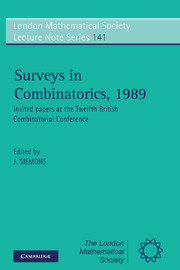Book contents
- Frontmatter
- PREFACE
- Contents
- On the theory of designs
- Designs: mappings between structured sets
- Developments based on Rado's dissertation ‘Studien zur Kombinatorik’
- Designs and automorphism groups
- On matchings and Hamiltonian cycles in random graphs
- Decompositions of complete bipartite graphs
- On the method of bounded differences
- On the use of regular arrays in the construction of t-designs
- The ‘Snake Oil’ method for proving combinatorial identities
On the use of regular arrays in the construction of t-designs
Published online by Cambridge University Press: 05 August 2013
- Frontmatter
- PREFACE
- Contents
- On the theory of designs
- Designs: mappings between structured sets
- Developments based on Rado's dissertation ‘Studien zur Kombinatorik’
- Designs and automorphism groups
- On matchings and Hamiltonian cycles in random graphs
- Decompositions of complete bipartite graphs
- On the method of bounded differences
- On the use of regular arrays in the construction of t-designs
- The ‘Snake Oil’ method for proving combinatorial identities
Summary
INTRODUCTION
A t–design S(λ; t, k, v) is a collection of k–subsets, called blocks, of a v-set S such that any t-subset of S is contained in exactly λ blocks. An S(λ; 2, k, v) is often called a (v, k, λ)-design and an S(λ; t, k, v) is often called a t-(v, k, λ)- design. An S(λ; t, k, v) is called simple if it contains no repeated blocks* It has been known for a long time that there are a lot of S(λ; t, k, v) for all t, see [6, 23]. However, until relatively recently, the only known examples of simple t-designs with t ≥ 6 were the trivial t-designs consisting of all k-subsets of a v-set. The first examples of non-trivial simple 6-designs were found by Magliveras and Leavitt [9]. In [19], we constructed nontrivlal simple t-designs for all t. It is not the purpose of this paper to give another proof of the main result of [19], as a simplified proof Is already given in [21]. Rather, we will survey construction techniques for t-designs using totally symmetric regular arrays, or, equlvalently, regular extended designs. These techniques played a major role in the construction of non-trivial simple t-designs for arbitrary t. We will point out the relationship between the techniques of [19, 21] and results of Wilson, Schreiber, Beth and Lu, as well as other results of the author and folklore direct product constructions.
- Type
- Chapter
- Information
- Surveys in Combinatorics, 1989Invited Papers at the Twelfth British Combinatorial Conference, pp. 189 - 207Publisher: Cambridge University PressPrint publication year: 1989

